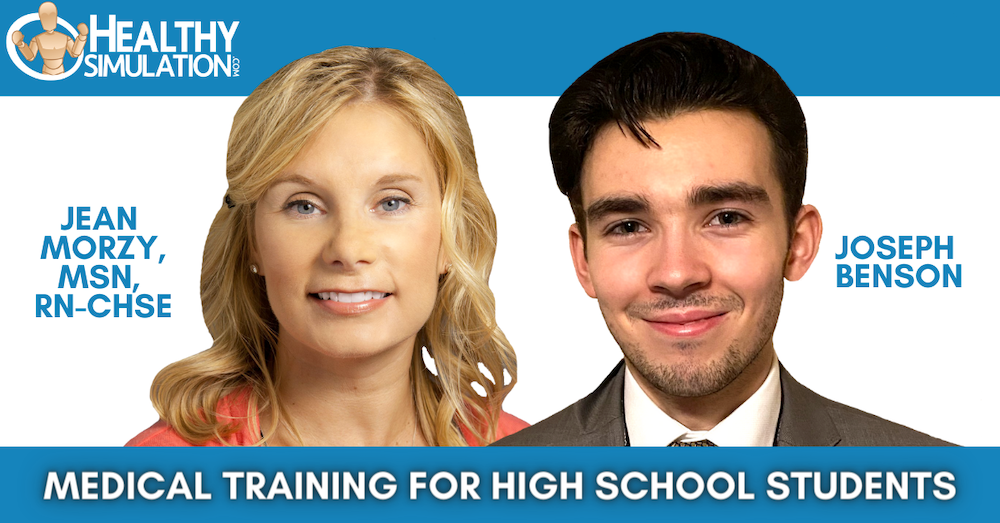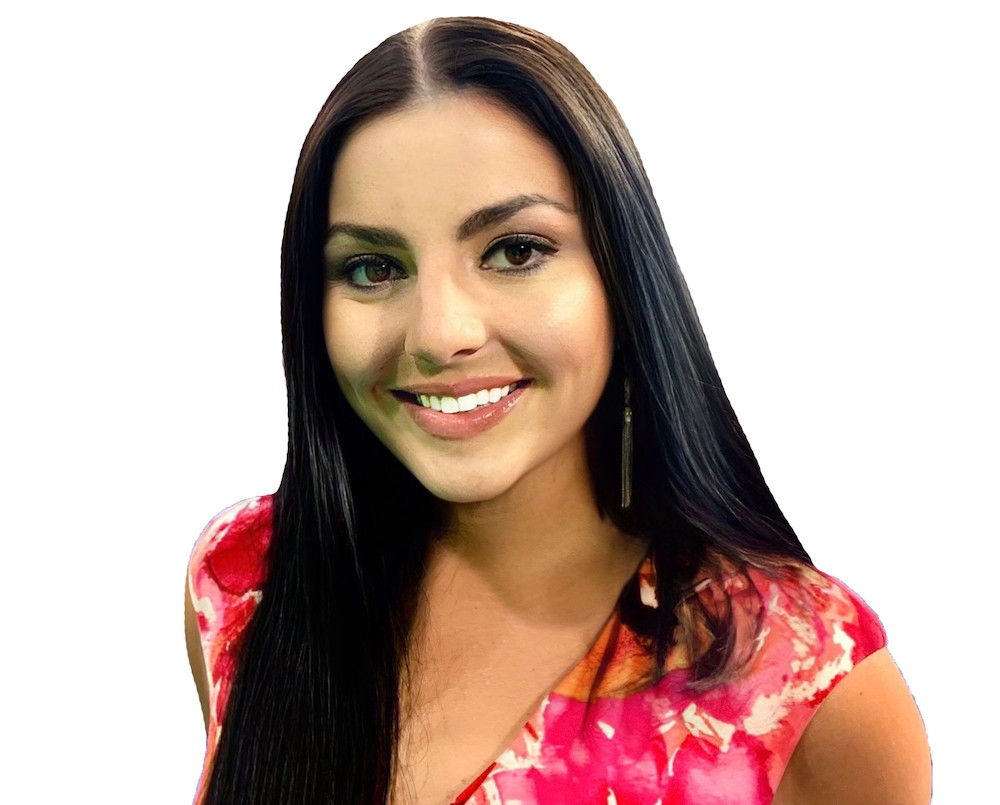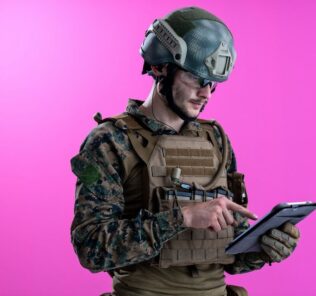Medical Training for High School Students: How These Healthcare Simulation Programs Are Changing the Game
Medical training for high school students is undergoing a revolution in outcomes, thanks to new medical simulation technologies. While healthcare simulation education is used at many colleges and universities worldwide, clinical simulation is less often part of high school curricula. This absence of medical simulation within high school programs is due to a number of factors, including finances, opportunity and awareness. Helping to change this notion and bring healthcare simulation into the classroom, Jean Morzy MSN, RN-CHSE, the manager of the simulation center at Organizational Learning in the Wisconsin metropolitan area, and Joe Benson, clinical skills lead at Liverpool Life Sciences UTC in Liverpool, United Kingdom, have both pushed for clinical simulation in secondary education. Recently, they shared why they think beginning healthcare simulation education at this stage is beneficial for tomorrow’s healthcare learners.
HealthySim: Why is the innovative healthcare simulation space an important part of the secondary education curriculum?
Jean Morzy: Healthcare simulation requires the application of knowledge. Throughout secondary education programs, information is presented to students using various pedagogical methods in the hope that they will be able to apply this new information naturally. Unfortunately, little is incorporated into curricula to teach students how to apply their new knowledge. Most questions on tests in secondary education programs are intended for learners to prove they know just the facts. Thus the following questions arise: How does a teacher create an environment to practice critical thinking skills by applying the new facts that remain in many schools? What if the teachers create an opportunity for students to learn from each other or even allow them to trial their conclusions without fear of consequence?
Sponsored Content:
The internal thought process that each student engages in personally during and after a healthcare simulation experience, combined with the discussions led by the teacher to include the contribution of other students during a debriefing session, do more to develop their understanding of the content than many other classroom activities. Additionally, healthcare simulation experiences increase students’ confidence in their ability to apply the information independently when faced with similar situations. They are more comfortable asking questions to challenge their understanding and questioning the actions of others to better sort out their own thought processes.
Joe Benson: High school students have always left for university with a great deal of knowledge and academic ability. However, in 1997 the Dearing Report outlined that there was a gap in practical skills among students who had started their undergraduate education. Liverpool Life Sciences University Technical Colleges (UTC) was set up to equip students with sector-specific skills. This was so that when they began their undergraduate studies, UTC graduates would have a baseline level of practical and applied knowledge to add to their academic achievements, leading them to improve their career prospects.
The Liverpool Life Sciences UTC is the United Kingdom’s only school designed to deliver high-fidelity healthcare simulation. We have developed specific programs for each year group:
- Year 9 Students (aged 14 to 15): Learn hand hygiene, auscultating the chest, using basic airway adjuncts
- Year 10/11 Students (aged 15 to 6): Learn basic procedures such as the ABCDE approach to assessing a patient, treating an acute asthma attack (using a three step method) and how to carry out a number of more advanced procedures such as venipuncture, cannulating and setting up an IV for a patient.
The UTC builds toward more advanced skills with our older sixth form students (aged 16 to 19) who add to these skills by acting as a team leader (for example in ACLS), learning more in-depth skills such as endotracheal intubation and learning about the causes of some of the conditions they learn to treat. These can include understanding the roles of histamine and mast cells in an asthma attack and using this knowledge to treat the patient with the best-suited medications — in this case salbutamol and hydrocortisone.
Sponsored Content:
HealthySim: What are the benefits of offering healthcare simulation learning at this level? Does it help to make learners’ transition to an undergrad clinical simulation education program more seamless?
Jean Morzy: The benefits of offering healthcare simulation in secondary education programs is only as good as the program providing the experience. The simplicity of a well-written story problem has been an acceptable form of clinical simulation for many years in secondary education. In contrast, if the story problem is not well written, students become confused and doubt their understanding of the information. The same can be said of healthcare simulation experiences. A strong foundation in the clinical simulation standards is vital.
Unfortunately, the importance of the designation of faculty time needed for members to educate themselves on how to properly integrate healthcare simulations into their classes continues to be severely underestimated. The clinical simulation standards create a consistent, intentional experience in a safe learning environment. Without those components, a healthcare simulation-based learning experience can increase the risk of harming students’ academic growth.
The secondary education programs that I have had the pleasure of collaborating with embrace the responsibility associated with creating strong healthcare simulation programs. Many of them look for support from experts, either in the field of focus or in medical simulation/adult-learning principles. Opportunities have been created such as inspiring future architects to design an operating room to challenge potential nurses, doctors, and anesthesiologists on their knowledge of lung pathophysiology, while auscultating adventitious lung sounds on a high-fidelity simulator. With the creation of a fun game requiring students to put on full personal protective equipment (PPE), not only can healthcare simulation support new information learned in science class, but the training measure can validate a personal comfort level in the PPE that would never be imagined possible until experienced.
After taking part in some of the healthcare simulation experiences, students have obtained jobs in healthcare to continue to develop their professional goals. Certified nursing assistant programs offered in secondary education environments create opportunities for future healthcare professionals to get hands-on experience with patients. These programs integrate clinical simulation into their programs, preparing them for future simulated experiences in undergraduate programs. Additionally, some of these opportunities can cause students to reevaluate the healthcare profession they thought they wanted to pursue.
In past roles working in academic settings, students from various programs (nursing, occupational therapy, pharmacy, etc.) would willingly share their secondary education experiences with healthcare simulation. They remembered details of the standardized patient in the scenario along with what they learned as a result of the experience. Some shared good experiences while others described less-than-optimal experiences. Regardless of which type of experience they had, I led the discussion to focus on what they did learn because of the healthcare simulation. Secondary education programs that include clinical simulation are providing the students an opportunity to apply what they have learned to future medical simulations that they will experience in higher educational healthcare programs.
Joe Benson: Using this high level of healthcare simulation allows our students to give their studies a practical application and gives real-life context to their curriculum studies. The idea of five years of university following two years of college can often sound daunting. Using clinical simulation as an incentive can allow students to remember why their chosen career is special to them and encourage them to continue on their path. Our students arrive at university with an array of practical skills, knowledge of OSCEs and experience completing and being marked on their performance in them, giving them an edge and confidence in their skills.
HealthySim: What is the transition from healthcare simulation learning in secondary education to undergrad like? Are there gaps in information between program levels?
Jean Morzy: As innovation has influenced the methodology of healthcare simulation possibilities, some teachers have started to integrate clinical simulation into their classes. In my experience, the transition is directly correlated to the quality of the secondary education program and to the engagement of the student. Most healthcare undergraduate programs include clinical simulation within the program. The medical simulations begin with simple demonstration of skills and progress to complex patient-care scenarios. Experience of any kind sets an individual apart from someone who has none.
The collaboration between secondary education programs and undergraduate programs is still in its infancy. They are learning how to best support each other for the betterment of the student, the secondary education program, and the college/university. As these relationships continue to grow, gaps that are seen now have the opportunity to dissipate with consistent collaboration between programs.
Joe Benson: Obviously gaps will be present, as our students condense a five-year degree into five terms at school. This means that they will learn a brief overview of a number of important and prominent areas, but the depth of these is often remarkably greater than any other students at this level would study in the United Kingdom. The format for healthcare simulation at the UTC is broken down into seminars, skills and clinical simulation sessions, meaning that a semi-realistic view of university study in these areas is encouraged.
HealthySim: Do you maintain relationships with educators at the undergrad level to assess outcomes and share common healthcare simulation/educational goals?
Jean Morzy: In my current role in a hospital-based healthcare simulation center we are not assessing outcomes or education goals with secondary education programs. A two-hour program has been developed targeting junior and senior students. The program is not just focused on nurses, doctors, and other common healthcare roles, but rather highlights the importance of technology development, construction and architecture, interior design and artists, culinary professions, and many other important roles vital to healthcare. Not every one of those professions has a healthcare simulated experience during the two-hour session; however, we incorporate discussing them during the simulated experiences.
We have provided this two-hour experience specifically for teachers and guidance counselors from our local high schools to educate them on the opportunities in healthcare, too. We have received very positive feedback from the experience. The educators shared that they were unaware of many of the professions available in healthcare.
A few teachers who have brought their students to our two-hour experience have reached out to explore other opportunities that they could facilitate with their students. We even helped a high school receive a grant to purchase a VR system for its health science program based on the experience we provided in our program. Additionally, a community-based program is in development to provide high school students with the opportunity to become a certified nursing assistant, which would then lead to a relationship with a local college nursing program. Healthcare simulation-based learning is foundational to that program, which led to initial consulting on what that would look like for them.
Joe Benson: At the UTC we maintain good relationships with prominent figures in the industry, education and medicine so that our students can meet and learn from the very best in the field. We work with industry partners and local NHS trusts to build a foundation of knowledge and skills with our students through Project-based Learning and facilitating students’ self-led research in our state-of-the-art labs.
HealthySim: In your experience, does beginning healthcare simulation education earlier lead to better healthcare programs overall?
Jean Morzy: Again, healthcare simulation requires application of knowledge. The more experience learners are given throughout every aspect of their professional journey, the more knowledge they will have obtained to apply to real-life situations. One can only conclude that with additional clinical simulation experiences designed with the healthcare simulation standards, students will arrive at healthcare programs with more knowledge and improved critical thinking skills. A favorite quote from comedian Steven Wright reads, “Experience is something you don’t get until just after you need it.” I feel this captures healthcare simulation perfectly. We have the opportunity to create consistent, intentional experiences for students … and we need to provide more!
Joe Benson: Allowing our students to fail in a forward direction is a key value of our healthcare simulation program. High stress, low-risk environments are the perfect space to encourage our future medics and nurses to experiment, try new skills and study new illnesses or body systems in a safe and welcoming atmosphere. With healthcare simulation, students have the opportunity to build an understanding of the foundational skills taught in medicine. This means that they can apply this to their study and work on special projects as a result of gaining skills early.
HealthySim: What simulator tools are you using (specifically what brand and product) and how, and for what outcomes?
Jean Morzy: We currently are not using tools for secondary education experiences within our healthcare simulation center.
Joe Benson: Currently, our faculty relies on a SimMan Essential and a high-fidelity sim-suite. We are always looking to expand and work with new partners and expand our horizons. The desired outcome of our healthcare simulation suite may appear to challenge the status quo for medical education, however our aims line up with those of many others: building team skills, continuing education, and allowing our students the opportunity to fail now rather than when it counts.
About Jean Morzy MSN, RN-CHSE
Jean Morzy MSN, RN-CHSE Jean Morzy MSN, RN-CHSE is the manager of the simulation center at Organizational Learning in the Wisconsin metropolitan area. She has worked in the academic setting and was involved in the opening of a healthcare simulation center at a Level 1 Trauma Center. Throughout her career, Morzy has participated in every role possible in healthcare simulation.
About Joe Benson:
Joe Benson is clinical skills and clinical simulation lead at Liverpool Life Sciences UTC in Liverpool, United Kingdom. This is the only ‘high school-level’ healthcare simulation program in the United Kingdom. He works as a conduit between the worlds of medicine and education, allowing students to learn the essence of clinical practice, communication skills and more advanced aspects of training such as anesthetics, minor surgery and leadership under pressure, preparing students for further education and eventual medical careers.
Subscribe for More Great Simterviews!
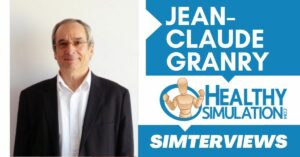
Simterview Avec le Professeur Jean Claude Granry, Pionnier Français de la Simulation en Santé
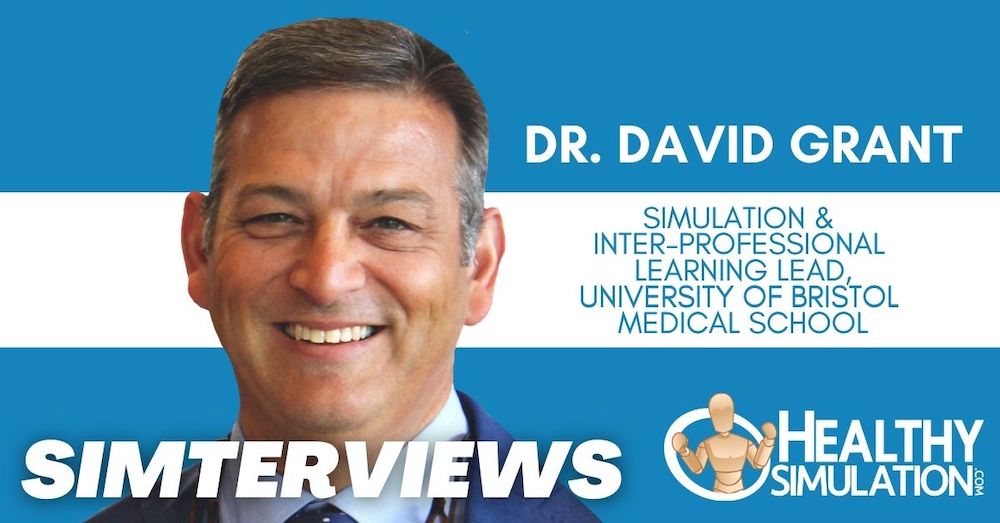
Simterviews: Dr. David Grant | Simulation Learning Lead, University of Bristol Medical School
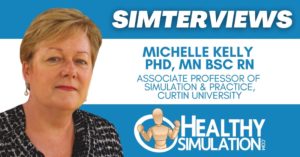
Simterviews: Dr. Michelle Kelly | Associate Professor of Simulation & Practice, Curtin University
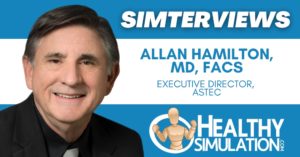
Simterviews: Dr. Allan Hamilton | Executive Director, ASTEC
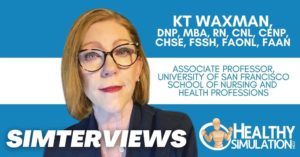
Simterviews: Dr. KT Waxman | Associate Professor at the Associate Professor at the University of San Francisco School of Nursing and Health Professions
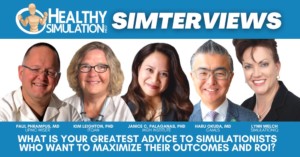
Simterviews: Medical Simulation Experts Discuss Ways to Maximize ROI
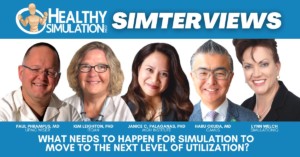
Simterviews: Medical Simulation Experts Discuss Next Level of Healthcare Simulation Utilization
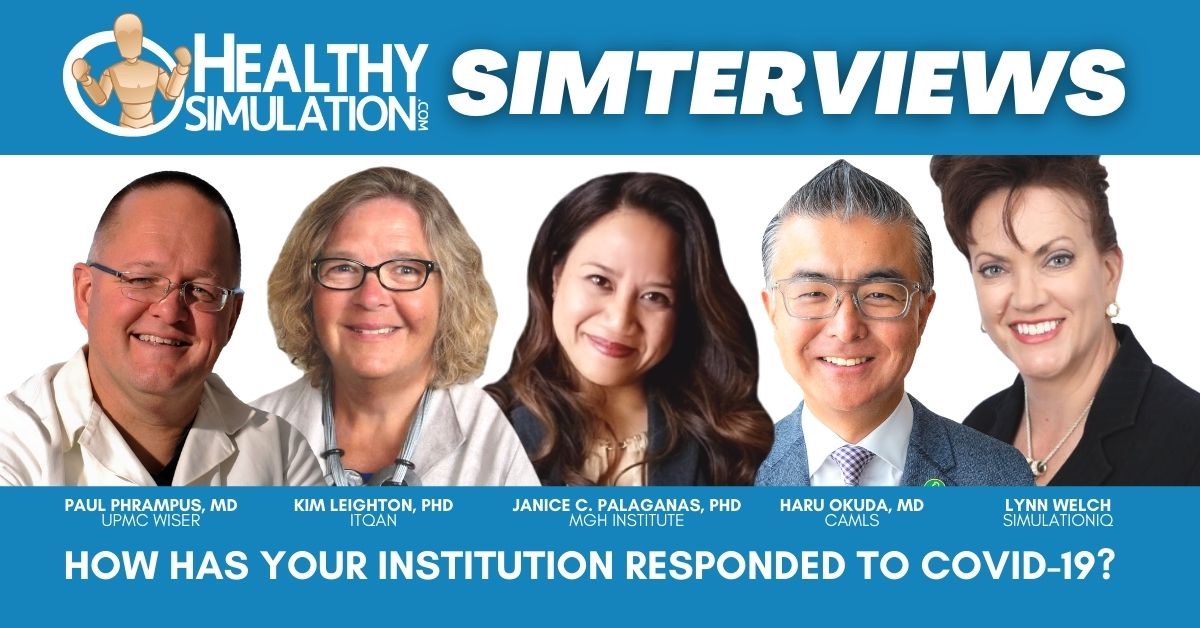
Simterviews: Medical Simulation Experts Discuss COVID-19 Responses
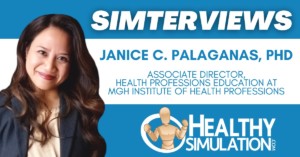
Simterviews: Dr. Janice Palaganas | Associate Director of PhD Program, MGH Institute
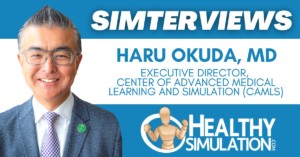
Simterviews: Dr. Haru Okuda | Executive Director, CAMLS
Lindsey Nolen is the Content Director for HealthySimulation.com. She is an award-winning journalist with years of experience writing about the many different facets of healthcare, including clinical simulation education and training. She also helped create content for the healthcare career information website, CareersinHealthcare.com.
Sponsored Content:



